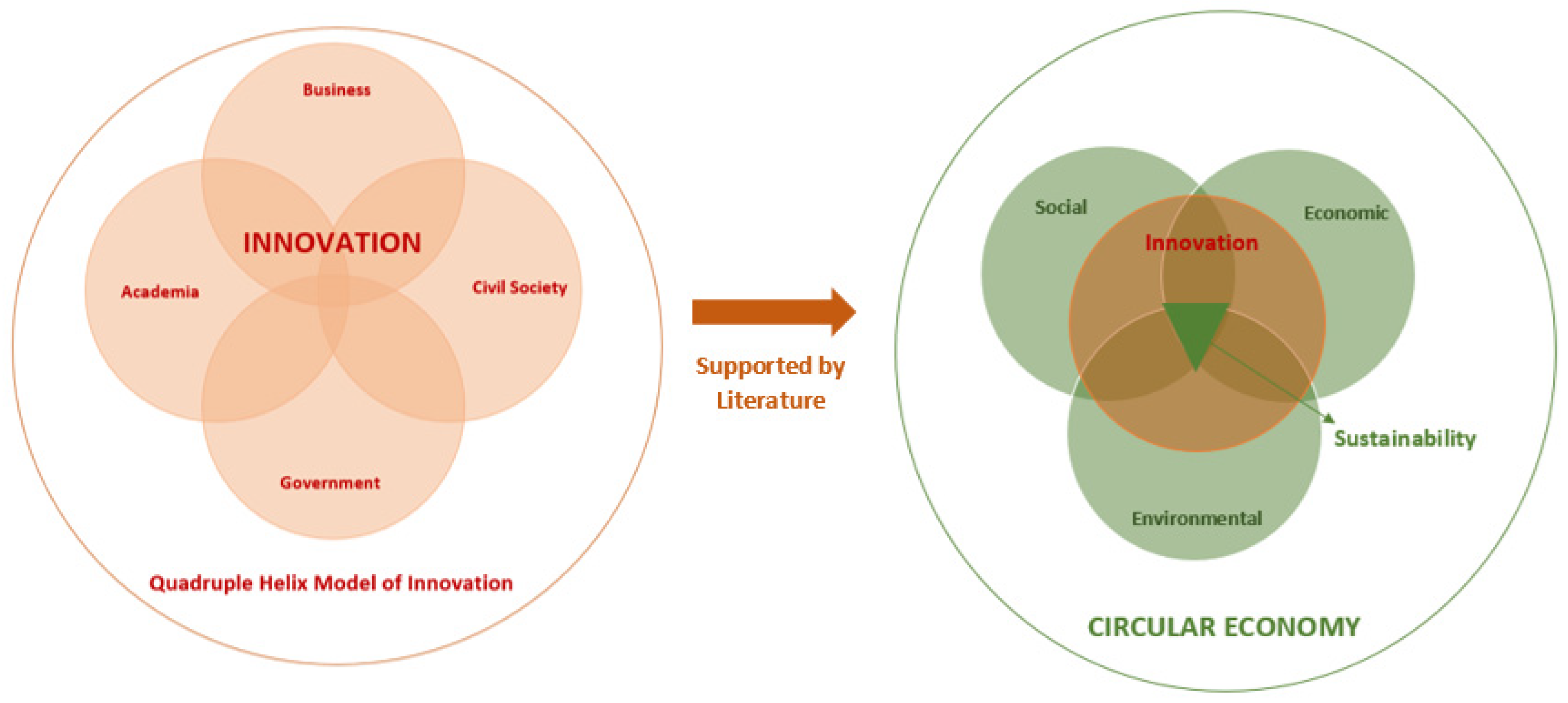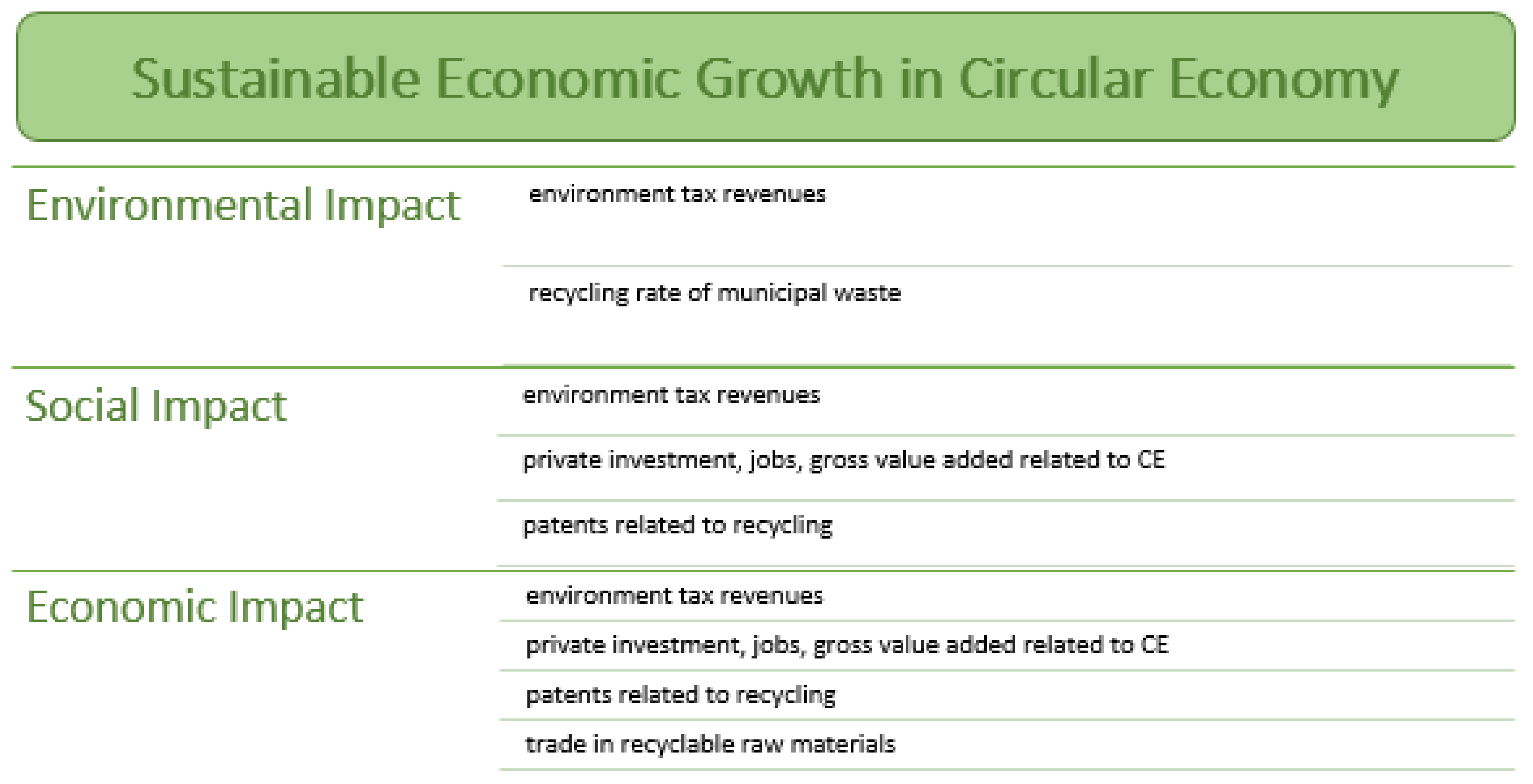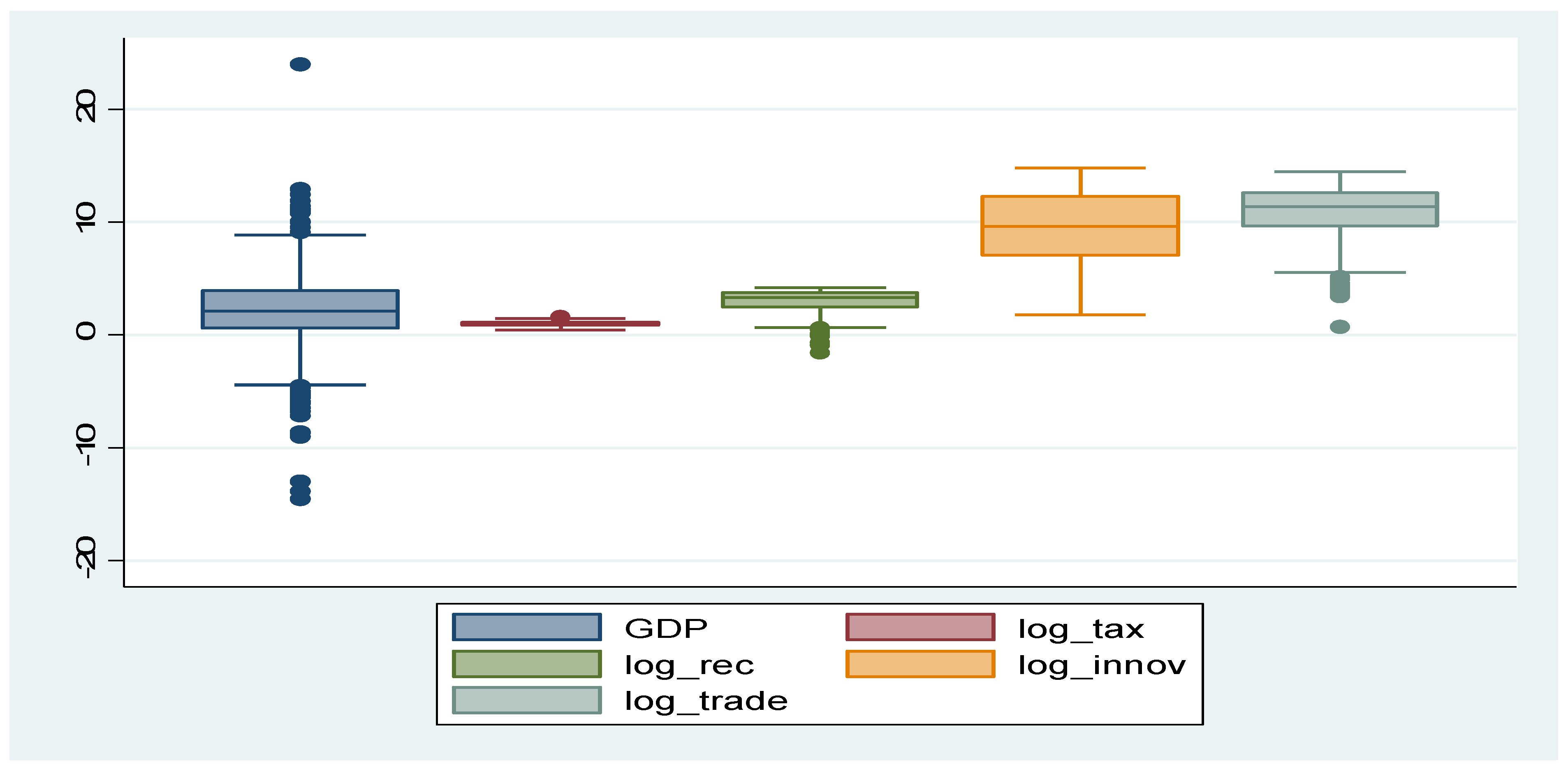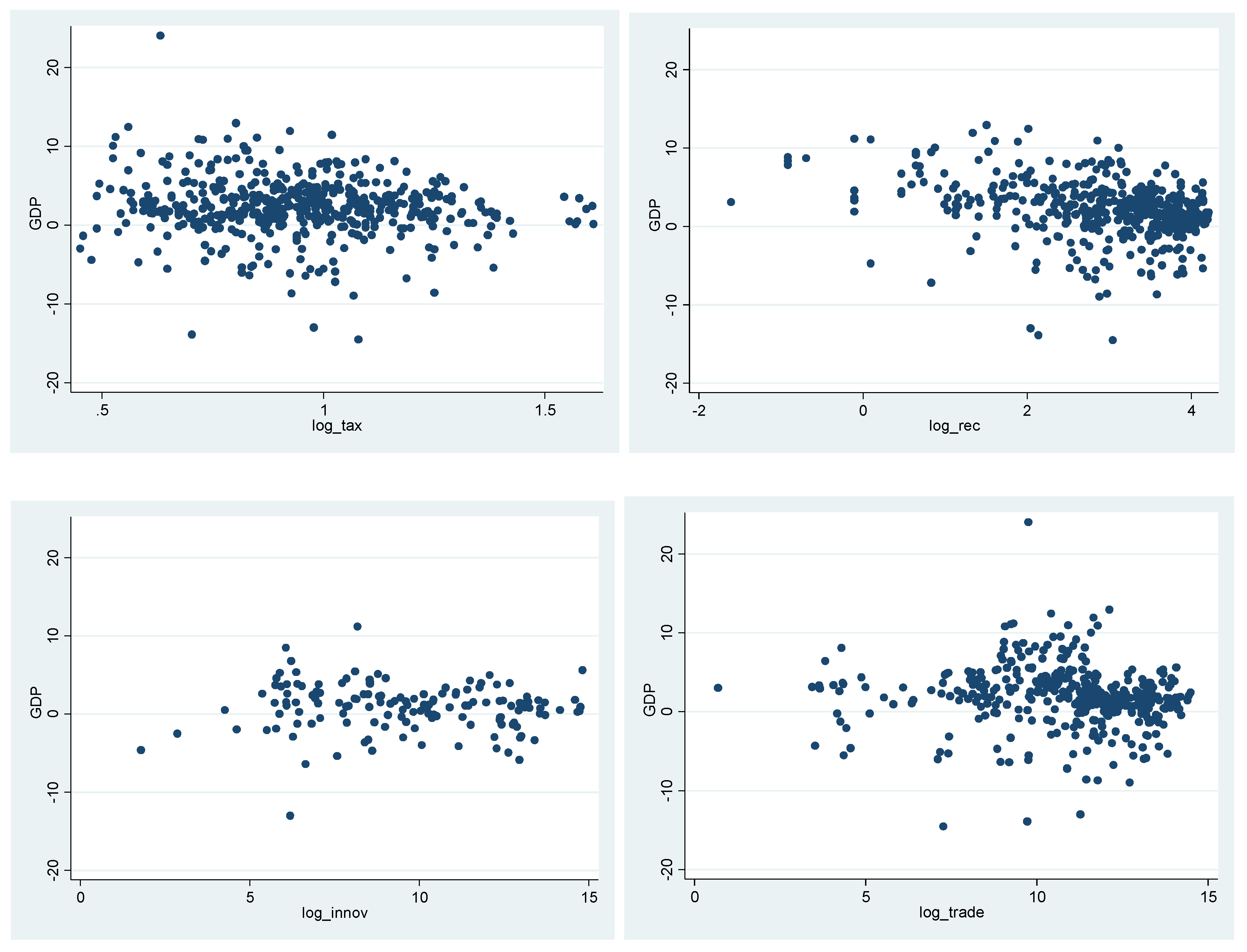Circular Economy Innovation and Environmental Sustainability Impact on Economic Growth: An Integrated Model for Sustainable Development
Abstract
1. Introduction
- RQ1:
- Are CE components supportive of sustainability?
- RQ2:
- To what extent do the CE components impact GDP?
- H1a:
- The CE “environment” aspect has a positive impact on GDP.
- H1b:
- The CE “social” aspect has a positive impact on GDP.
- H1c:
- The CE “economic” aspect has a positive impact on GDP.
2. Literature Review on Circular Economy
2.1. From a Linear to a Circular Economy
2.2. From Circularity to Sustainability
3. Materials and Methods
3.1. Circular Economy Indicators
- -
- Environment Tax Revenues (defined as var1)
- -
- Recycling Rate of Municipal Waste (defined as var2)
- -
- Private Investment, Jobs, Gross Value Added related to CE (defined as var3)
- -
- Patents related to Recycling (defined as var4)
- -
- Trade-in Recyclable Raw Materials (defined as var5)
3.2. Data
4. Results
5. Discussion and Conclusions
- (1)
- all CE indicators considered in this study are found to positively affect economic growth;
- (2)
- if the CE indicators are associated with the sustainable economic development triangle adopted for the circular economy (environmental–social–economic), the findings show that they have a positive effect on economic growth as well;
- (3)
- theoretically and empirically based, the study underpins the necessity of innovation in the core of CE;
- (4)
- this study emphasizes and strongly supports the stipulation of the collaboration among academia, government, business, and civil society.
Author Contributions
Acknowledgments
Conflicts of Interest
Appendix A
References
- Bakker, C.A.; den Hollander, M.C.; van Hinte, E.; Zijlstra, Y. Products that Last: Product Design for Circular Business Models; TU Delft Library Delft, Marcel den Hollander IDRC: Deft, The Netherlands, 2014. [Google Scholar]
- Bocken, N.; Short, S.; Rana, P.; Evans, S. A literature and practice review to develop sustainable business model archetypes. J. Clean. Prod. 2014, 65, 42–56. [Google Scholar] [CrossRef]
- MacArthur, E. Towards the Circular Economy. J. Ind. Ecol. 2013, 23–44. [Google Scholar]
- Rashid, A.; Asif, F.M.; Krajnik, P.; Nicolescu, C.M. Resource Conservative Manufacturing: An essential change in business and technology paradigm for sustainable manufacturing. J. Clean. Prod. 2013, 57, 166–177. [Google Scholar] [CrossRef]
- Webster, K. The Circular Economy: A Wealth of Flows; Ellen MacArthur Foundation: Cowes Isle of Wight, UK, 2015. [Google Scholar]
- Lieder, M.; Rashid, A. Towards circular economy implementation: A comprehensive review in context of manufacturing industry. J. Clean. Prod. 2016, 115, 36–51. [Google Scholar] [CrossRef]
- Ghisellini, P.; Cialani, C.; Ulgiati, S. A review on circular economy: The expected transition to a balanced interplay of environmental and economic systems. J. Clean. Prod. 2016, 114, 11–32. [Google Scholar] [CrossRef]
- Laurenti, R.; Singh, J.; Frostell, B.; Sinha, R.; Binder, C.R. The Socio-Economic Embeddedness of the Circular Economy: An Integrative Framework. Sustainabilty 2018, 10, 2129. [Google Scholar] [CrossRef]
- Ma, Y.; Rong, K.; Luo, Y.; Wang, Y.; Mangalagiu, D.; Thornton, T.F. Value Co-creation for sustainable consumption and production in the sharing economy in China. J. Clean. Prod. 2019, 208, 1148–1158. [Google Scholar] [CrossRef]
- Boulding, K.E. The Economics of the Coming Spaceship Earth. Environmental Quality in a Growing Economy: Essays from the Sixth RFF Forum; Baltimore, H.J., Ed.; John Hopkins University Press: New York, NY, USA, 1996; pp. 3–14. [Google Scholar]
- Sopjani, L.; Arekrans, J.; Laurenti, R.; Ritzén, S. Unlocking the Linear Lock-In: Mapping Research on Barriers to Transition. Sustainability 2020, 12, 1034. [Google Scholar] [CrossRef]
- European Commision. Closing the Loop—an EU Action Plan for the Circular Economy—COM, 614 Final; European Commission: Brussels, Belgium, 2015. [Google Scholar]
- Khitous, F.; Strozzi, F.; Urbinati, A.; Alberti, F. A Systematic Literature Network Analysis of Existing Themes and Emerging Research Trends in Circular Economy. Sustainabilty 2020, 12, 1633. [Google Scholar] [CrossRef]
- Geissdoerfer, M.; Savaget, P.; Bocken, N.M.; Hultink, E.J. The Circular Economy—A new sustainability paradigm? J. Clean. Prod. 2017, 143, 757–768. [Google Scholar] [CrossRef]
- Muniz, R.; Cruz, M.J. Making Nature Valuable, Not Profitable: Are Payments for Ecosystem Services Suitable for Degrowth? Sustainability 2015, 7, 10895–10921. [Google Scholar] [CrossRef]
- Shiva, V. Recovering the real meaning of sustainability. In The Environment in Question: Ethics and Global Issues; Cooper, D., Palmer, J.A.E., Eds.; Routledge: London, UK, 1992; pp. 187–193. [Google Scholar]
- Berg, A.; Antikainen, R.; Hartikainen, E.; Kauppi, S.; Kautto, P.; Lazarevic, D.; Piesik, S.; Saikku, L. Circular Economy for Sustainable Development; Reports of the Finnish Environment Institute; Finnish Environment Institute (SYKE): Helsinki, Finland, 2018; Volume 26. [Google Scholar]
- Lazarevic, D.; Valve, H. Narrating expectations for the circular economy: Towards a common and contested European transition. Energy Res. Soc. Sci. 2017, 31, 60–69. [Google Scholar] [CrossRef]
- Kirchherr, J.; Reike, D.; Hekkert, M. Conceptualizing the circular economy: An analysis of 114 definitions. Resour. Conserv. Recycl. 2017, 127, 221–232. [Google Scholar] [CrossRef]
- Trica, C.L.; Banacu, C.S.; Busu, M. Environmental Factors and Sustainability of the Circular Economy Model at the European Union Level. Sustainabilty 2019, 11, 1114. [Google Scholar] [CrossRef]
- Busu, M.; Trica, C.L. Sustainability of Circular Economy Indicators and Their Impact on Economic Growth of the European Union. Sustainabilty 2019, 11, 5481. [Google Scholar] [CrossRef]
- Hill, T.D.; Davis, A.P.; Roos, J.M.; French, M.T. Limitations of Fixed-Effects Models for Panel Data. Sociol. Perspect. 2019, 0731121419863785. [Google Scholar] [CrossRef]
- Arellano, M.; Bond, S. Some Tests of Specification for Panel Data: Monte Carlo Evidence and an Application to Employment Equations. Rev. Econ. Stud. 1991, 58, 277. [Google Scholar] [CrossRef]
- Ellen MacArthur Foundation. Towards the circular economy: Economic and business rationale for an accelerated transition; Report commissioned by the Ellen MacArthur Foundation; Ellen MacArthur Foundation: Cowes Isle of Wight, UK, 2012. [Google Scholar]
- Murray, A.; Skene, K.R.; Haynes, K. The Circular Economy: An Interdisciplinary Exploration of the Concept and Application in a Global Context. J. Bus. Ethic. 2015, 140, 369–380. [Google Scholar] [CrossRef]
- Kruja, A.D. Sustainable Economic Development, a Necessity of the 21st Century. Mediterr. J. Soc. Sci. 2013, 4, 93–98. [Google Scholar] [CrossRef][Green Version]
- Jackson, T. Prosperity without Growth; Informa UK Limited: London, UK, 2009. [Google Scholar]
- Sposato, P.; Preka, R.; Cappellaro, F.; Cutaia, L. Sharing Economy and Circular Economy. How Technology and Collaborative Consumption Innovations Boost Closing the Loop Strategies. Environ. Eng. Manag. J. 2017, 16, 1797–1806. [Google Scholar] [CrossRef]
- Stahel, W. The Performance Economy; Palgrave Macmillan: Basingstroke, UK, 2010. [Google Scholar]
- Yun, J.J.; Liu, Z.; Yun. Liu Micro- and Macro-Dynamics of Open Innovation with a Quadruple-Helix Model. Sustainability 2019, 11, 3301. [Google Scholar] [CrossRef]
- Etkowitz, H.; Leydersdorff, L. The Triple Helix—University-Industry-Government Relations: A Laboratory for Knowledge Based Economic Development. Glycoconj. J. 1995, 14, 14–19. [Google Scholar]
- Carayannis, E.G.; Campbell, D.F.J. ‘Mode 3’ and ‘Quadruple Helix’: Toward a 21st century fractal innovation ecosystem. Int. J. Techn. Manag. 2009, 46, 201–234. [Google Scholar] [CrossRef]
- Haupt, M.; Hellweg, S. Measuring the environmental sustainability of a circular economy. Environ. Sustain. Indic. 2019, 1, 100005. [Google Scholar] [CrossRef]
- Liu, Y.; Bai, Y. An exploration of firms’ awareness and behavior of developing circular economy: An empirical research in China. Resour. Conserv. Recycl. 2014, 87, 145–152. [Google Scholar] [CrossRef]
- Ramani, K.; Ramanujan, D.; Bernstein, W.Z.; Zhao, F.; Sutherland, J.; Handwerker, C.; Choi, J.-K.; Kim, H.; Thurston, D. Integrated Sustainable Life Cycle Design: A Review. J. Mech. Des. 2010, 132, 091004. [Google Scholar] [CrossRef]
- Wrinkler, H. Closed-loop production systems e a sustainable supply chain approach. CIRP J. Manuf. Sci. Technol. 2011, 4, 243–246. [Google Scholar] [CrossRef]
- Geng, Y.; Zhu, Q.; Doberstein, B.; Fujita, T. Implementing China’s circular economy concept at the regional level: A review of progress in Dalian, China. Waste Manag. 2009, 29, 996–1002. [Google Scholar] [CrossRef] [PubMed]
- Naustdalslid, J. Circular economy in China–the environmental dimension of the harmonious society. Int. J. Sustain. Dev. World Ecol. 2014, 21, 303–313. [Google Scholar]
- Su, B.; Heshmati, A.; Geng, Y.; Yu, X. A review of the circular economy in China: Moving from rhetoric to implementation. J. Clean. Prod. 2013, 42, 215–227. [Google Scholar] [CrossRef]
- European Commision. Measuring Progress Towards Circular Economy in the European Union—Key Indicators for a Monitoring Framework-SWD, 17 Final; European Commission: Strasbourg, France, 2018. [Google Scholar]
- Moraga, G.; Huysveld, S.; Mathieux, F.; Blengini, G.A.; Alaerts, L.; Van Acker, K.; De Meester, S.; Dewulf, J. Circular economy indicators: What do they measure? Resour. Conserv. Recycl. 2019, 146, 452–461. [Google Scholar] [CrossRef]
- Garcia-Bernabeu, A.; Caballero, A.H.; Pla-Santamaria, D.; Salas-Molina, F. A Process Oriented MCDM Approach to Construct a Circular Economy Composite Index. Sustainability 2020, 12, 618. [Google Scholar] [CrossRef]
- Busu, M.; Nedelcu, A.C. Sustainability and Economic Performance of the Companies in the Renewable Energy Sector in Romania. Sustainabilty 2017, 10, 8. [Google Scholar] [CrossRef]
- Laci, B.; Hysa, E. Albania’s Challenge to Access in European Common Market. Econ. Insights Trends Chall. 2015, 4, 11–19. [Google Scholar]
- Federica, C.; D’Adamo, I.; Gastaldi, M. Future Trajectories of Renewable Energy Consumption in the European Union. Resources 2018, 7, 10. [Google Scholar] [CrossRef]
- Busu, M. Busu Adopting Circular Economy at the European Union Level and Its Impact on Economic Growth. Soc. Sci. 2019, 8, 159. [Google Scholar] [CrossRef]
- Berhani, R.; Hysa, E. The Economy of Albania Today and then: The Drivers to Growth. In Proceedings of the 4th International Conference on European Studies, Tirana, Albania, 10 November 2013; p. 598. [Google Scholar]
- Alfaro, E.; Yu, F.; Rehman, N.U.; Hysa, E.; Kabeya, P.K. Strategic management of innovation. In Proceedings of the Routledge Companion to Innovation Management, Routledge, London, UK; 2019; pp. 107–168. [Google Scholar]
- Aid, G.; Lazarevic, D.; Kihl, A. Waste to resources: Moving toward the 2030 sustainable development goals. In Proceedings of the Linnaeus Eco-Tech, Kalmar, Sweden, 21–23 November 2016; pp. 1–19. [Google Scholar]
- Kihl, A.; Aid, G. Driving Forces and Inhibitors of Secondary Stock Extraction. Open Waste Manag. J. 2016, 9, 11–18. [Google Scholar] [CrossRef]
- Hozo, S.P.; Djulbegovic, B.; Hozo, I. Estimating the mean and variance from the median, range, and the size of a sample. BMC Me Res. Methodol. 2005, 5, 13. [Google Scholar] [CrossRef]
- Hair, J.F.; Ringle, C.M.; Sarstedt, M. Partial Least Squares Structural Equation Modeling: Rigorous Applications, Better Results and Higher Acceptance. Long Range Plan. 2013, 46, 1–12. [Google Scholar] [CrossRef]
- Soto, M. System GMM Estimation with Small Sample; Universitat Autonoma de Barcelona Working Paper: Barcelona, Spain, 2009; pp. 1–26. [Google Scholar]
- Feruni, N.; Hysa, E. Free Trade and Gravity Model: Albania as Part of Central European Free Trade Agreement (CEFTA). In Theoretical and Applied Mathematics in International Business; IGI Global: Hershey, PA, USA, 2020; pp. 60–90. [Google Scholar]




| Variable | Variable Definition * | Observ. | St. Dev. | Min | Max | Mean | Median |
|---|---|---|---|---|---|---|---|
| Gdp | GDP per cap. growth (annual %) | 504 | 3.710 | −14.560 | 23.985 | 2.219 | 2.0981 |
| log_tax | Log (Proportion of env. tax revenues in GDP) | 502 | 0.221 | 0.457 | 1.6094 | 0.941 | 0.9321 |
| log_rec | Log (Recycling Rate of Municipal Waste) | 487 | 1.028 | −1.609 | 4.214 | 2.973 | 3.2847 |
| log_innov | Lvog (Priv. Inv., Jobs, Gross Val. Add. x Patents related to Recycling) | 145 | 2.817 | 1.784 | 14.818 | 9.634 | 9.6001 |
| log_trade | Log (Trade in Recycl. Raw Mat.) | 392 | 2.407 | 0.693 | 14.493 | 10.864 | 11.3897 |
| Economic Growth [(GDP Per Capita)] | EU Countries |
|---|---|
| Environmental Tax Revenues [L1.log_tax] | 11.6908 *** (4.0962) |
| Recycling Rate of Municip. Waste [L1.log_rec] | 2.4378 *** (0.7476) |
| Innovation (Priv. Invest, Jobs in CE * Patents related Recycling) [L1.log_innov] | 0.6854 * (0.4235) |
| Trade in Recyclable Raw Mat. [L1.log_trade] | 0.0863 (0.5874) |
| R-sq. (overall) | 0.0029 |
| F-Stat | 10.80 *** |
| Rho | 0.7460 |
| Observations | 135 |
| Nb. of Groups | 23 |
| Economic Growth [(GDP Per Capita)] | EU Countries |
|---|---|
| GDP per capita [L1.gdp] | −0.0814 (0.0749) |
| Environmental Tax Revenues [L1.log_tax] | 15.6481 *** (3.3311) |
| Recycling Rate of Municip. Waste [L1.log_rec] | 1.6581 *** (0.5499) |
| Innovation (Priv. Invest, Jobs in CE * Patents related Recycling) [L1.log_innov] | 0.4267 (0.3657) |
| Trade-in Recyclable Raw Mat. [L1.log_trade] | 0.4621 (0.4599) |
| Wald chi2(5) | 55.71 |
| Prob > chi2 | 0.0000 |
| Number of instruments | 89 |
| Observations | 101 |
| Nb. of Groups | 22 |
© 2020 by the authors. Licensee MDPI, Basel, Switzerland. This article is an open access article distributed under the terms and conditions of the Creative Commons Attribution (CC BY) license (http://creativecommons.org/licenses/by/4.0/).
Share and Cite
Hysa, E.; Kruja, A.; Rehman, N.U.; Laurenti, R. Circular Economy Innovation and Environmental Sustainability Impact on Economic Growth: An Integrated Model for Sustainable Development. Sustainability 2020, 12, 4831. https://doi.org/10.3390/su12124831
Hysa E, Kruja A, Rehman NU, Laurenti R. Circular Economy Innovation and Environmental Sustainability Impact on Economic Growth: An Integrated Model for Sustainable Development. Sustainability. 2020; 12(12):4831. https://doi.org/10.3390/su12124831
Chicago/Turabian StyleHysa, Eglantina, Alba Kruja, Naqeeb Ur Rehman, and Rafael Laurenti. 2020. "Circular Economy Innovation and Environmental Sustainability Impact on Economic Growth: An Integrated Model for Sustainable Development" Sustainability 12, no. 12: 4831. https://doi.org/10.3390/su12124831
APA StyleHysa, E., Kruja, A., Rehman, N. U., & Laurenti, R. (2020). Circular Economy Innovation and Environmental Sustainability Impact on Economic Growth: An Integrated Model for Sustainable Development. Sustainability, 12(12), 4831. https://doi.org/10.3390/su12124831








